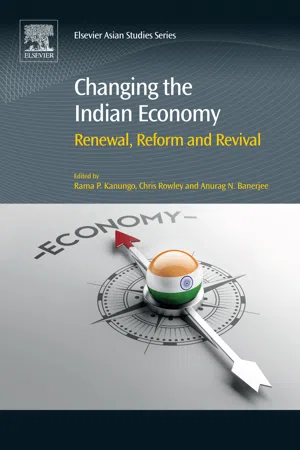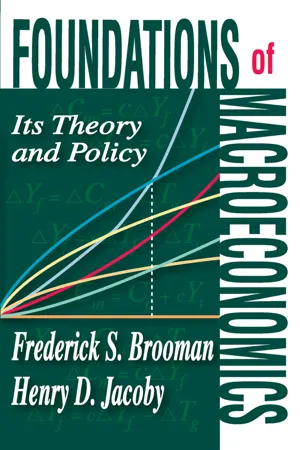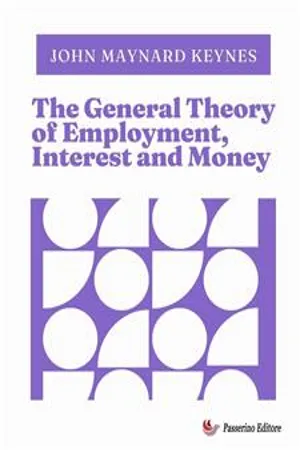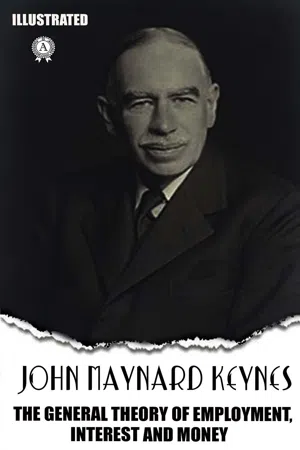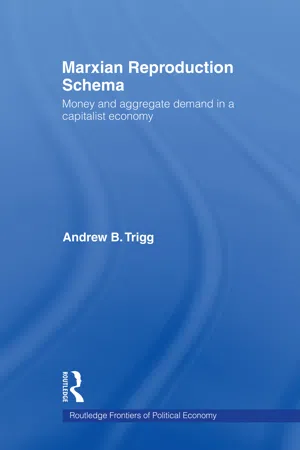Economics
Expenditure Multiplier
The expenditure multiplier is a concept in economics that measures the impact of changes in spending on overall economic activity. It reflects the idea that an initial increase in spending leads to a multiplied effect on national income and output. The multiplier effect occurs as the additional income generated by the initial spending is re-spent, further stimulating economic activity.
Written by Perlego with AI-assistance
Related key terms
Related key terms
1 of 4
Related key terms
1 of 3
8 Key excerpts on "Expenditure Multiplier"
- eBook - ePub
- Alvin H Hansen(Author)
- 2013(Publication Date)
- Routledge(Publisher)
General Theory. The magnitude of the leakages is determined by the portion of the marginal income which is not used for consumption expenditures, or, in other words, is saved. Thus, if the percentage saved is zero, the Multiplier is infinity. If the fraction which is saved is one tenth, the Multiplier is ten; if one fifth, five; if one third, three; if one half, two; and, finally, if 100 per cent is saved, the Multiplier is one, and, similarly, for intervening points. The Multiplier is thus the reciprocal of the marginal propensity to save, which determines the ratio of marginal saving to marginal income received. The Multiplier can equally well be stated in terms of the marginal propensity to consume. The Multiplier (K) stated in terms of the marginal propensity-to-consumeFrom Charts 15 and 16 it is readily apparent that the income will not remain at the new high level reached unless the private investment or governmental outlays continue to be poured out in a continuous stream. As soon as the governmental expenditures are withdrawn, the income again falls to its previous level. This phenomenon is in no sense a peculiarity of governmental spending, but is equally true of private investment expenditures.The Acceleration PrincipleThus, the Multiplier Principle concerns exclusively the effect of private investment expenditure or governmental expenditure, as the case may be, upon subsequent net additions to consumption expenditure. The Acceleration Principle, to which we now turn, concerns exclusively the effect of a net increase in consumption expenditures upon induced investment expenditures. If we are to measure the full effect of private investment expenditures or governmental expenditures, as the case may be, on income, we must take account of both the Multiplier and the Acceleration Principle; we must measure not only the effect of these initial expenditures upon subsequent consumption, but also the effect of the subsequent increases in consumption upon investment induced by increase in consumption expenditures.The volume of replacement investment expenditures is determined by the volume of consumption expenditures. In the event that consumption expenditures remain constant, no new - eBook - ePub
- Alfred Schipke, Aliona Cebotari, and Nita Thacker(Authors)
- 2013(Publication Date)
- INTERNATIONAL MONETARY FUND(Publisher)
Tax and public Expenditure Multipliers provide a quantitative measure of the change in output resulting from an increase in taxes or government spending, and are key parameters for evaluating the effectiveness of fiscal policies in managing output fluctuations. A public spending multiplier greater than 1 indicates that public expenditure is able to stimulate economic activity and produce a final increase in output larger than the initial increase in public spending. A multiplier less than 1 means that the initial increase in aggregate demand is eroded by effects that counteract the initial unitary increase in public spending. These counteracting effects are often due to the crowding out of productive private sector activities and because part of the intended fiscal impulse translates into higher imports that do not increase output. Taxes are expected to have a negative effect on GDP, so a multiplier of less than –1 would imply that collecting one unit of taxes causes a decrease in economic activity larger than one unit. This outcome could be due to the accompanying distortions created by an increase in taxes or to disincentives for productive private sector activities. A tax multiplier less than zero but more than –1 indicates that economic activity is able to at least partially recover from the initial effect of the extraction of one unit of output in the form of taxes.An estimate of the size of fiscal multipliers is essential to the design and implementation of fiscal policies. If public spending multipliers are smaller than expected, a country’s economy may end up in a trajectory that compromises the sustainability of public finance because expansionary fiscal policies will fail to boost economic activity sufficiently, and public indebtedness (together with the associated debt service) will increase as a percentage of GDP. Also, a tax multiplier that is larger than expected may end up depressing economic activity more than anticipated, ultimately eroding the tributary base from which all taxes are collected.The magnitude of fiscal multipliers has been under close scrutiny since the 2008–09 global financial and economic crisis. The crisis prompted large government intervention through tax reductions and expenditure programs across the world aimed at preventing a global deflationary scenario (see, for instance, Spilimbergo and others, 2008 ; Freedman and others, 2009 ; Hall, 2009 ; and Spilimbergo, Symansky, and Schindler, 2009 - eBook - ePub
Changing the Indian Economy
Renewal, Reform and Revival
- Rama P. Kanungo, Chris Rowley, Anurag N. Banerjee(Authors)
- 2018(Publication Date)
- Elsevier(Publisher)
This section also lists the econometric alternatives for robust estimation of the multiplier effects. Section 3 describes the data and methods used for the analysis. Section 4 presents the key findings obtained when using the structural vector auto-regression (SVAR) model to test the effectiveness of the specified categories of public expenditure. Section 5 concludes by discussing the policy implications and the limitations of the study. 2 Review of the literature The classical school of thought promoted a laissez-faire approach whereby public expenditure was confined to the maintenance of law and order and other essential government activities (i.e. defence). However, following the Great Depression, the Keynesian Revolution established an indispensable role for public expenditure in determining the level of income and employment in an economy. The upshot of the general theory was the need for government intervention in the management of aggregate demand (Keynes, 1936). The concept of the fiscal multiplier was credited to Kahn (1931) but was popularized by Keynes (1936). Later, Hicks (1950) advanced the concept to the super-multiplier, which combined the effect of increased investment due to increased income along with the multiplier. The Keynesian approach was initially synonymous with fiscal policies but the role of monetary factors was also subsequently appreciated by the Keynesians (Tobin, 1987, 1997). However, following the 1970s stagflation, the Keynesian approach was subsided by alternative theoretical views on the limited efficacy of public spending on economic stability (Monetarism, New Classical and Real Business Cycle School). Nevertheless, New Keynesians maintained that government intervention was critical for macroeconomic stability, as capitalist economies display poor speeds of convergence towards long-run equilibrium (Snowdown and Vane, 2005) - eBook - ePub
Foundations of Macroeconomics
Its Theory and Policy
- Frederick S. Brooman(Author)
- 2017(Publication Date)
- Routledge(Publisher)
This version of the Multiplier, working through the transactions relationships of the various sectors, may be called the “Multi-Sector” or “Matrix” Multiplier. Introduc-ing time lags (which need not, of course, be the same for all sectors) will make it dynamic, raising the possibility of oscillations as it did in the Lundbergian case. Further analysis, however, would require the use of matrix algebra, with which the reader is not assumed to be familiar; in the present text, therefore, the matter will be left at this point. 20 7. The “Employment” Multiplier So far, the Multiplier concept has been presented in terms of output: an autonomous change in demand induces further changes, leading to a multiple rise in the equilibrium level of National Product. It should be noted, however, that the Multiplier was first introduced (by R. F. Kahn in 1931 21) as a ratio between levels of employment: an initial rise in investment creates “primary” employment for workers engaged directly on new capital projects, and their spending then gives rise to “secondary” employment in the industries producing consumer goods; the ratio between the overall rise in employment and the primary employment is the “Employment” Multiplier. If the proportion between output and employment – i.e., the productivity of labor – were the same for all levels of output, there would be no difference between the value of the Employment Multiplier (k☼) and the ordinary multiplier (k). But, as was argued in Chapter 4 (pp. 69–70), output per unit of labor may be expected to fall as output increases toward the full-employment level; if this happens, k ☼ should be larger than k when the Multiplier is working to increase output and employment, but smaller when it is working in the opposite direction - John Maynard Keynes(Author)
- 2023(Publication Date)
- Passerino(Publisher)
10. The Marginal Propensity to Consume and the Multiplier
WE established in Chapter 8 that employment can only increase pari passu with investment. We can now carry this line of thought a stage further. For in given circumstances a definite ratio, to be called the Multiplier, can be established between income and investment and, subject to certain simplifications, between the total employment and the employment directly employed on investment (which we shall call the primary employment). This further step is an integral part of our theory of employment, since it establishes a precise relationship, given the propensity to consume, between aggregate employment and income and the rate of investment. The conception of the multiplier was first introduced into economic theory by Mr. R. F. Kahn in his article on “The Relation of Home Investment to Unemployment” ( Economic Journal, June 1931). His argument in this article depended on the fundamental notion that, if the propensity to consume in various hypothetical circumstances is (together with certain other conditions) taken as given and we conceive the monetary or other public authority to take steps to stimulate or to retard investment, the change in the amount of employment will be a function of the net change in the amount of investment; and it aimed at laying down general principles by which to estimate the actual quantitative relationship between an increment of net investment and the increment of aggregate employment which will be associated with it. Before coming to the multiplier, however, it will be convenient to introduce the conception of the marginal propensity to consume.IThe fluctuations in real income under consideration in this book are those which result from applying different quantities of employment ( i.e. of labour-units) to a given capital equipment, so that real income increases and decreases with the number of labour-units employed. If, as we assume in general, there is a decreasing return at the margin as the number of labour-units employed on the given capital equipment is increased, income measured in terms of wage-units will increase more than in proportion to the amount of employment, which, in turn, will increase more than in proportion to the amount of real income measured (if that is possible) in terms of product. Real income measured in terms of product and income measured in terms of wage-units will, however, increase and decrease together (in the short period when capital equipment is virtually unchanged). Since, therefore, real income, in terms of product, may be incapable of precise numerical measurement, it is often convenient to regard income in terms of wage-units (Y w ) as an adequate working index of changes in real income. In certain contexts we must not overlook the fact that, in general, Y w- eBook - ePub
- James C.W. Ahiakpor(Author)
- 2003(Publication Date)
- Routledge(Publisher)
12 The mythology of the Keynesian multiplier
Introduction1
Among the most misleading concepts in modern macroeconomics is the Keynesian multiplier. It is also the main building block of Keynes’s (1936) aggregate demand management, and income and employment creation theory. The multiplier concept invites acceptance by building on two fundamental truths: (a) people typically consume a fraction of their income and (b) such purchases for consumption are incomes for sellers. Thus, the concept argues that consumption spending releases purchasing power to producers and thereby validates their investment plans. Saving plays no positive role in supplying the funds for investment in Keynes’s reasoning, for example, “The investment market can become congested through the shortage of cash. It can never become congested through the shortage of saving” (1937:669), and “Saving has no special efficacy as compared with consumption, in releasing cash and restoring liquidity” (1938:321).Furthermore, according to the argument, consumption spending creates a multiplier effect from some initial “autonomous” expenditure such that, in a simplified model, national income increases by a factor (k). That is, , where T is nominal income (GDP), k is the multiplier, s is the marginal propensity to save is the marginal propensity to consume, and Z is the “autonomous” expenditure, such as investment or government expenditure that does not depend on domestic savings. Keynes (1933, 1936), by his elaboration of Richard Kahn’s (1931) earlier argument, thus exalts consumption spending to a magical significance in macroeconomic analysis, contrary to the classical emphasis on savings as the fountain of investment funds for production and employment growth, as explained in Chapter 9 - John Maynard Keynes(Author)
- 2021(Publication Date)
- Strelbytskyy Multimedia Publishing(Publisher)
Chapter 10
THE MARGINAL PROPENSITY TO CONSUME AND THE MULTIPLIER
We established in chapter 8 that employment can only increase pari passu with investment unless there is a change in the propensity to consume. We can now carry this line of thought a stage further. For in given circumstances a definite ratio, to be called the multiplier , can be established between income and investment and, subject to certain simplifications, between the total employment and the employment directly employed on investment (which we shall call the primary employment ). This further step is an integral part of our theory of employment, since it establishes a precise relationship, given the propensity to consume, between aggregate employment and income and the rate of investment. The conception of the multiplier was first introduced into economic theory by Mr R. F. Kahn in his article on 'The Relation of Home Investment to Unemployment' (Economic Journal , June 1931). His argument in this article depended on the fundamental notion that, if the propensity to consume in various hypothetical circumstances is (together with certain other conditions) taken as given and we conceive the monetary or other public authority to take steps to stimulate or to retard investment, the change in the amount of employment will be a function of the net change in the amount of investment; and it aimed at laying down general principles by which to estimate the actual quantitative relationship between an increment of net investment and the increment of aggregate employment which will be associated with it. Before coming to the multiplier, however, it will be convenient to introduce the conception of the marginal propensity to consume .IThe fluctuations in real income under consideration in this book are those which result from applying different quantities of employment (i.e. of labour-units) to a given capital equipment, so that real income increases and decreases with the number of labour-units employed. If, as we assume in general, there is a decreasing return at the margin as the number of labour-units employed on the given capital equipment is increased, income measured in terms of wage-units will increase more than in proportion to the amount of employment, which, in turn, will increase more than in proportion to the amount of real income measured (if that is possible) in terms of product. Real income measured in terms of product and income measured in terms of wage-units will, however, increase and decrease together (in the short period when capital equipment is virtually unchanged). Since, therefore, real income, in terms of product, may be incapable of precise numerical measurement, it is often convenient to regard income in terms of wage-units (Y w ) as an adequate working index of changes in real income. In certain contexts we must not overlook the fact that, in general, Y w- eBook - ePub
- Andrew Trigg(Author)
- 2006(Publication Date)
- Routledge(Publisher)
6 Workers are hired to produce thisTable 2.3 Locating the multiplier in Department 1output, and with their wages they purchase further amounts of output, which result in the hiring of more workers, and so on. The initial impact of the 500 units of investment multiplies throughout the economy, creating four times more income than the original injection—a net income of 2,000. The multiplier is easily located, with a value of 4 in Department 1 of Marx’s expanded reproduction schema.Having nested the multiplier in the reproduction schema, some attention can be given to its structure. As a starting point, the Keynesian income multiplier takes the form(2.1) where y is aggregate net income, I is aggregate investment, and b is the propensity to consume. De Angelis (2000) examines the structure of the multiplier by defining the relationshipy =πL(2.2) where π represents labour productivity (y/L) and L is a measure of total labour in hours of work. It follows that the employment multiplier relationship(2.3) can be derived. De Angelis refers to 1/π −πb as the ‘social multiplier’, with the term πb defined as the ‘social wage rate’ and π −πb the profit per hour. Note that if B is the money value of total consumption we can write(2.4) The social wage rate is simply a ratio of consumption to labour, the consumption (in money units) per unit of labour power. A number of simplifying assumptions are made in order to relate equation (2.4) to Marxian economic categories. Capitalist consumption is assumed to be empirically negligible, a particularly unrealistic claim which can be relaxed later. In addition, there is assumed to be no exogenous element in worker consumption; and although workers are allowed to save, their savings are not included as part of the social wage rate. The social wage rate captures worker consumption B
Index pages curate the most relevant extracts from our library of academic textbooks. They’ve been created using an in-house natural language model (NLM), each adding context and meaning to key research topics.
Explore more topic indexes
Explore more topic indexes
1 of 6
Explore more topic indexes
1 of 4


